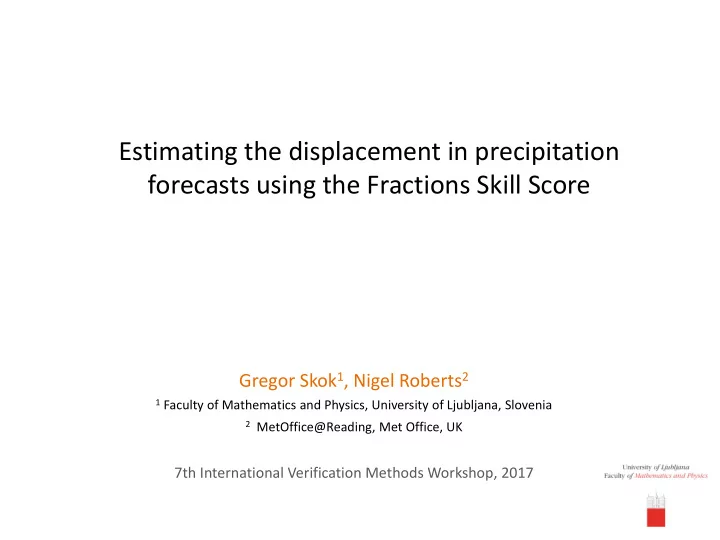

Estimating the displacement in precipitation forecasts using the Fractions Skill Score Gregor Skok 1 , Nigel Roberts 2 1 Faculty of Mathematics and Physics, University of Ljubljana, Slovenia 2 MetOffice@Reading, Met Office, UK 7th International Verification Methods Workshop, 2017
Fraction Skill Score (FSS) • FSS is a popular spatial verification method used for precipitation • It can be classed as a neighborhood approach method • In this study we focus on analyzing the ability of FSS to give a meaningful measure of spatial displacement of precipitation • The use of spatial displacement as a verification measure is very appealing for forecast interpretation since it is easy to understand and mimics how we tend to judge fields by eye • This ability has been hinted at in some previous studies/papers but never properly analyzed
FSS displacement A simple idealized setup (Roberts, 2008, Skok, 2015): 𝐺𝑇𝑇 = 1 − 𝑒/𝑜 d n 𝑒 𝐺𝑇𝑇 = 1 − 𝐺𝑇𝑇 ∙ 𝑜 FSS displacement -> If the FSS value is know at some neighborhood size the displacement can be determined exactly.
FSS displacement The big question !!! A simple idealized setup (Roberts, 2008, Skok, 2015): Since this recipe is strictly valid only for this 𝐺𝑇𝑇 = 1 − 𝑒/𝑜 simple idealized setup, how well does it work for more complicated idealized setups and for real d datasets? n 𝑜 ቚ 𝐺𝑇𝑇=0.5 𝑜 𝐺𝑇𝑇=0.5 ȁ 𝑒 𝐺𝑇𝑇 = 2 Usually the FSS value od 0.5 is used to determine the displacements -> we call this the FSS=0.5 rule . In this case the FSS displacements is half the neighborhood size.
Idealized setup 1: Two separated sets 𝑇 𝑐 𝑦 = 𝑇 𝑏 with S being area size of precipitation
Idealized setup 1: Two separated sets • An idealized setup with two separated sets is analyzed 𝑒 𝐺𝑇𝑇 = 𝑒 𝑏 + 𝑦 2 𝑒 𝑐 1 + 𝑦 2 • If sets are the same size ( 𝑦 = 1 ) 𝑒 𝐺𝑇𝑇 = 𝑒 𝑏 + 𝑒 𝑐 2 • If set B is quadruple size ( 𝑦 = 4 ) 𝑇 𝑐 𝑦 = 𝑇 𝑏 with S being area size of precipitation 𝑒 𝐺𝑇𝑇 = 𝑒 𝑏 + 𝟐𝟕 ∙ 𝑒 𝑐 17 In this case the FSS gives a meaningful representation of the displacement with larger areas havening an un-proportionally large effect .
The difference between two neighborhood Idealized setup 1: Two separated sets approaches (talk yesterday by Craig Schwartz) • - „smoothing radius“ – the larger areas An idealized setup with two separated sets is analyzed have the most influence on score value 𝑒 𝐺𝑇𝑇 = 𝑒 𝑏 + 𝑦 2 𝑒 𝑐 (the outliers are smoothed out) 1 + 𝑦 2 • If sets are the same size ( 𝑦 = 1 ) - „search radius“ - the influence of the smaller areas is increased 𝑒 𝐺𝑇𝑇 = 𝑒 𝑏 + 𝑒 𝑐 (the outliers are strengthened – possible 2 high sensitivity to noise) • If set B is quadruple size ( 𝑦 = 4 ) 𝑇 𝑐 𝑦 = 𝑇 𝑏 with S being area size of precipitation 𝑒 𝐺𝑇𝑇 = 𝑒 𝑏 + 𝟐𝟕 ∙ 𝑒 𝑐 17 In this case the FSS gives a meaningful representation of the displacement with larger areas havening an un-proportionally large effect .
Idealized setups 2 & 3: Random and envelope precipitation Random precipitation FSS displacements corresponds exactly to Random A the average distance to the closest neighboring rainy pixel Random B Envelopes of random precipitation FSS displacement will correspond to envelope distance (if the envelopes are far apart) or inter-envelope displacement (if the envelopes overlap)
Idealized setup 5: Overlapping precipitation
Idealized setup 5: Overlapping precipitation Simply using the 𝐺𝑇𝑇 = 1 − 𝑒/𝑜 equation does not work in case of significant overlap !!
Idealized setup 5: Overlapping precipitation Simply using the 𝐺𝑇𝑇 = 1 − 𝑒/𝑜 equation does not work in case of significant overlap !! A special overlap-adjustment needs to be made which takes into the account the portion of overlapping area. After applying the adjustment the results are much better !!!
Real cases 1: ECMWF operational forecasts 6h hourly precipitation starting at 00 UTC. 2% frequency threshold used. Analysis Forecast
Real cases 1: ECMWF operational forecasts 6h hourly precipitation starting at 00 UTC. 2% frequency threshold used. Analysis Forecast
Real cases 1: ECMWF operational forecasts 6h hourly precipitation starting at 00 UTC. 2% frequency threshold used. Analysis Forecast
Real cases 1: ECMWF operational forecasts 6h hourly precipitation starting at 00 UTC. 2% frequency threshold used. Analysis Forecast
Real cases 1: ECMWF operational forecasts 6h hourly precipitation starting at 00 UTC. 2% frequency threshold used. Analysis Forecast
Real cases 2: MesoVICT cases 1h hourly precipitation. 5% frequency threshold used.
Conclusions • The FSS can indeed be used to determine spatial displacement in a meaningful way. • The displacement provided by the FSS is directly related to the true displacements of precipitation but with larger precipitation objects having an unproportionally large influence. • It is recommended that the user should use a frequency (percentile) threshold unless biases are known to be small (the methodology can tolerate some bias but not too much)
Conclusions • The overlap-adjusted variant of the FSS displacement should be used • The computational cost in calculating d FSS is proportional to 𝑂 ∙ log[ 𝑂] (using Faggian et al., 2015 approach for the fast fraction calculation + bisection for finding ȁ 𝑜 𝐺𝑇𝑇=0.5 ). N is the number of grid points in the domain. • The d FSS measure provides only one aspect of verification – it is not the whole story • A paper will be submitted very soon • Planning to provide optimized R code for calculation of d FSS (also to SpatialVx ???)
Thank you !!
Recommend
More recommend